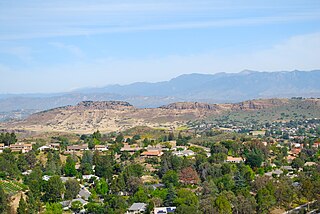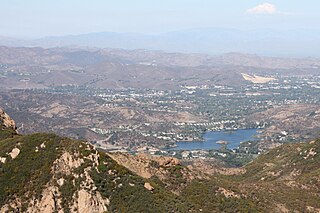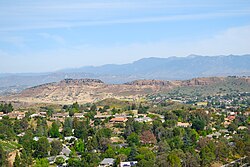
Thousand Oaks is a city in the northwestern part of Greater Los Angeles, approximately 15 miles (24 km) from the city of Los Angeles and 40 miles (64 km) from Downtown Los Angeles. The second-largest city in Ventura County, California, it is named after the many oak trees present in the area.

California Lutheran University is a private university in Thousand Oaks, California. It was founded in 1959 and is affiliated with the Evangelical Lutheran Church in America, but is nonsectarian. It opened in 1960 as California Lutheran College and was California's first four-year liberal arts college and the first four-year private college in Ventura County. It changed its name to California Lutheran University on January 1, 1986.

The Conejo Valley is a region spanning both southeastern Ventura County and northwestern Los Angeles County in Southern California, United States. It is located in the northwestern part of the Greater Los Angeles Area.
Newbury Park is a populated place and town in Ventura County, California, United States. Most of it lies within the western Thousand Oaks city limits, while unincorporated areas include Casa Conejo and Ventu Park. The town is located in Southern California around 8 miles (13 km) from the Pacific Ocean and has a mild year-round climate, scenic mountains, and environmental preservation. About 28,000 residents of Thousand Oaks reside in Newbury Park.

The Stagecoach Inn Museum in Newbury Park, California, originally known as the Grand Union Hotel, was used as a resting area for people who traveled from Los Angeles to Santa Barbara. Besides a hotel and stagecoach stop, it has also been used as a post office, church, restaurant and military school. It is California Historical Landmark No. 659 and is listed in the National Register of Historic Places. It played a major role in the development of the stage line transportation network in California. The hotel was also the first business venture in the Conejo Valley.

The Oaks is a two-level indoor/outdoor, regional shopping mall located in Thousand Oaks, California. It is owned and managed by Macerich. Accessible from US Highway 101 midway between downtown Los Angeles and Santa Barbara, it is the largest shopping center in Ventura County. Over five million visit the mall each year. The mall features JCPenney, Macy's, Macy's Men's and Home Store, Nordstrom, in addition to a 14-screen dine-in AMC Theatres.
The Norwegian Grade is a 2 miles (3.2 km) section of Moorpark Road from the Santa Rosa Valley up into the Simi Hills and the city of Thousand Oaks, within Ventura County, California. Completed in 1911, it may be one of the Norwegian Colony's most notable contributions to the city. Until the construction of California State Route 23 Freeway, this was the most direct route between Moorpark and Thousand Oaks.

The Joel McCrea Ranch in Thousand Oaks, California is also known as the August DuMortier Ranch. The ranch is a rare surviving example of the large cattle ranches and fields of grain which once dotted the Santa Rosa and Conejo valleys in eastern Ventura County.

Borchard Community Park is a public park located in western Newbury Park, CA. Situated adjacent to both the Newbury Park High School and the Borchard Maintenance Shop, the park is situated at the corner of Reino Road and Borchard Road at the foothills of the Santa Monica Mountains. The park encompasses 29 acres, which is home to various courts for recreational sports, fitness area, community rooms, a farm themed playground, picnic areas, several fields, and a skate park. The park was established by the Conejo Recreation & Park District (CRPD) in 1969. It has two volleyball courts, four tennis courts, two stages, three softball fields, a basketball court, barbecue grills, two bocci courts, a gymnasium, horseshoe pits, a kitchen, a soccer field, two playgrounds, and more.

Conejo Mountain is a 1,814-foot-high mountain (553 m) in Ventura County, California near Camarillo on the eastern boundary of the Oxnard Plain. At the western edge of the Conejo Valley, it is adjacent to the Santa Monica Mountains. Crossing what was once a formidable barrier for travelers, U.S. Route 101 passes through the area on the steep Conejo Grade.

Tarantula Hill, also known as Dawn’s Peak, is a 1,057-foot-high (322 m) peak in Thousand Oaks, California. It is located on a 45-acre (18 ha) open space and is operated by the Conejo Open Space Conservation Agency (COSCA). Climbing Tarantula Hill is a steep 0.5-mile (0.80 km) trail; the trailhead is located at 287 West Gainsborough Road, across the road from the main entrance to Conejo Valley Botanic Garden. Atop the mountain there is a 360-degree panoramic view of the Conejo Valley, the Simi Hills and the Santa Monica Mountains. There is also a fenced-in water reservoir located on top. It was once a popular hang-gliding site. It was once a volcanic mound but went dormant 16 million years ago.

Thousand Oaks Boulevard, previously known as Ventura Boulevard, is a street in the Conejo Valley, Ventura County. It stretches from Thousand Oaks through Westlake Village to Agoura Hills. In Thousand Oaks, it is located in the downtown area and was also known as Main Street until the Moorpark Freeway was completed in the 1960s. Today it remains one of the busiest commercial areas in Thousand Oaks, although many businesses are also located at The Oaks and Janss Marketplace. It is Thousand Oaks’ major east-west thoroughfare, connecting The Oaks mall on the west to Thousand Oaks Civic Arts Plaza in the east. It runs parallel to the Ventura Freeway. As of 2017, over 230 businesses are housed on Thousand Oaks Boulevard.
Reba Marie Hays Jeffries was one of the founders of Newbury Park Chamber of Commerce and later its first female president. She was a prominent supporter of Newbury Park cityhood and opposed the annexation by neighboring Thousand Oaks. She was also an outspoken supporter of preserving Stagecoach Inn and the Newbury Park Post Office when it was proposed that they be demolished.

Egbert Starr Newbury was the American founder of Newbury Park, California, and the first newspaper reporter in the Conejo Valley, located in Ventura County. Born and raised in Michigan, he moved to California in 1871 and settled in the Conejo Valley after buying land there in 1874, one of the first three European Americans to do so. He was appointed as the first postmaster in the Conejo Valley, and established the Newbury Park Post Office in 1875 at his house.

Conejo Recreation and Park District (CRPD) is the park management agency for most of the parks in the Conejo Valley, California. Established in 1962, CRPD later established Conejo Open Space Conservation Agency (COSCA) in 1977 through a joint effort with the City of Thousand Oaks. COSCA administers over 15,000 acres of open space and 140 miles of trails, while CRPD administers over 50 community parks. In 2019, CRPD's annual operating budget was $20 million, of which about 70% comes from property taxes.

Timber School was the first school in Newbury Park, California when established in 1889. and the current 1924 reconstructed Timber School is the oldest remaining school in the City of Thousand Oaks. It is also the oldest remaining public building in the Conejo Valley.

Newbury Road is the main street in Newbury Park, California, and runs parallel to the U.S. Route 101. The road is named for the town’s founder, Egbert Starr Newbury. The historic Newbury Park Post Office has had several locations on Newbury Road, including at the Stagecoach Plaza, a shopping complex with a name that implies the stagecoach heritage of the area. Stagecoach Plaza houses 14 restaurants and shops, and it is adjacent to additional shops on both sides.

Pederson House and Water Tower is located at the campus of California Lutheran University (CLU) in Thousand Oaks, California, the former home of the Norwegian Colony. It was built by members of the Colony that settled here in 1890. The structure is designated Ventura County Historic Landmark No. 45 and Thousand Oaks Historical Landmark No. 3. It is a typical turn-of-the-century farmhouse constructed in 1913-14 for Lars and Karn Pederson, Norwegian immigrants and members of the Norwegian Colony, who had first settled in Conejo Valley in 1890. The house was erected at the present location of Ahmanson Science Center, but was later relocated 500 feet (150 m) to its current location at the corner of Regent Avenue and Faculty Street. When its original location was determined to become a science building, the university was quoted $125,000 in moving costs, and therefore planned to demolish the house. However, CLU alumni were able to raise the amount in one day and were successful in saving the house.

The Newbury Park Post Office was the first post office in the Conejo Valley, established on July 16, 1875, by the valley's first postmaster, Egbert Starr Newbury.


















